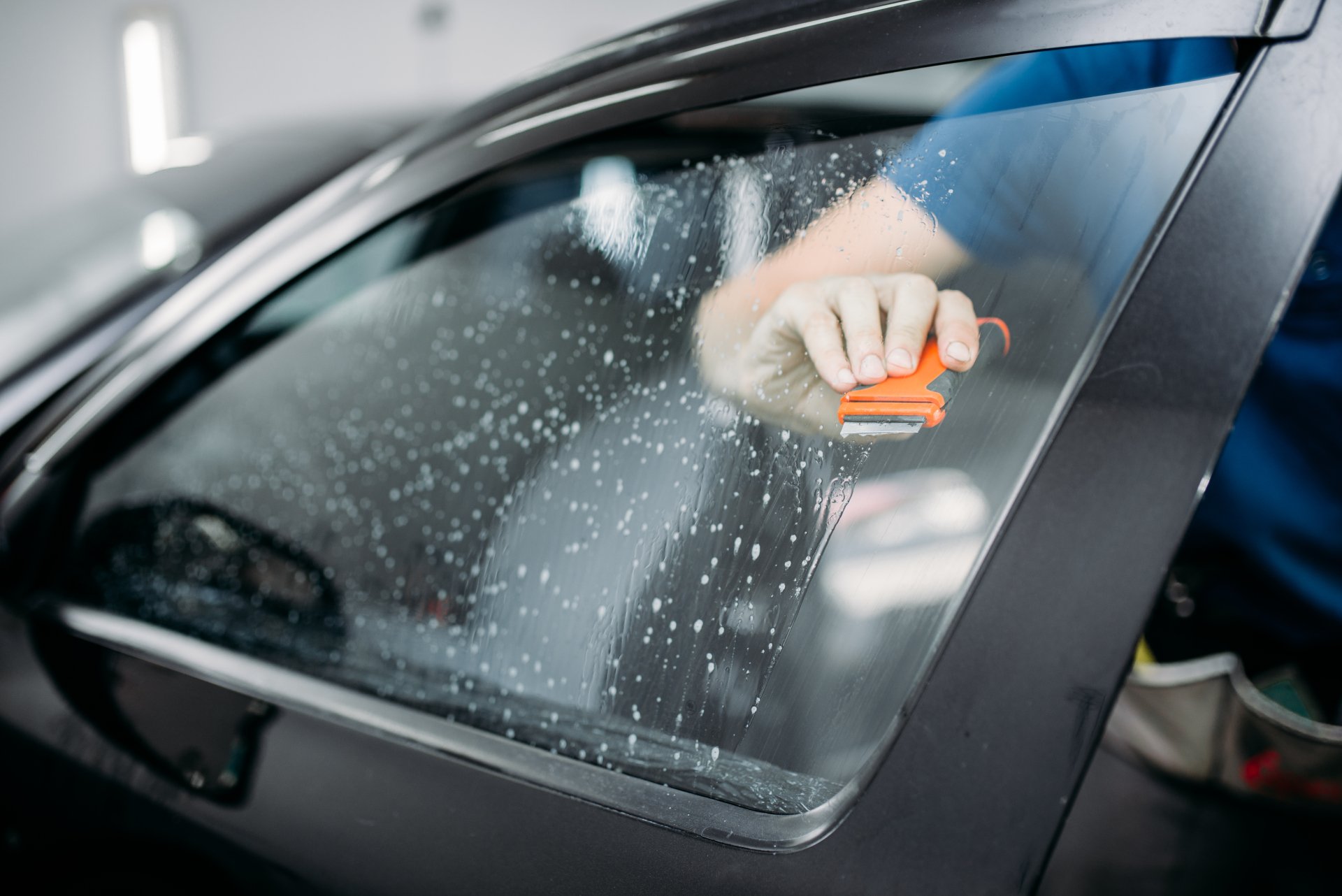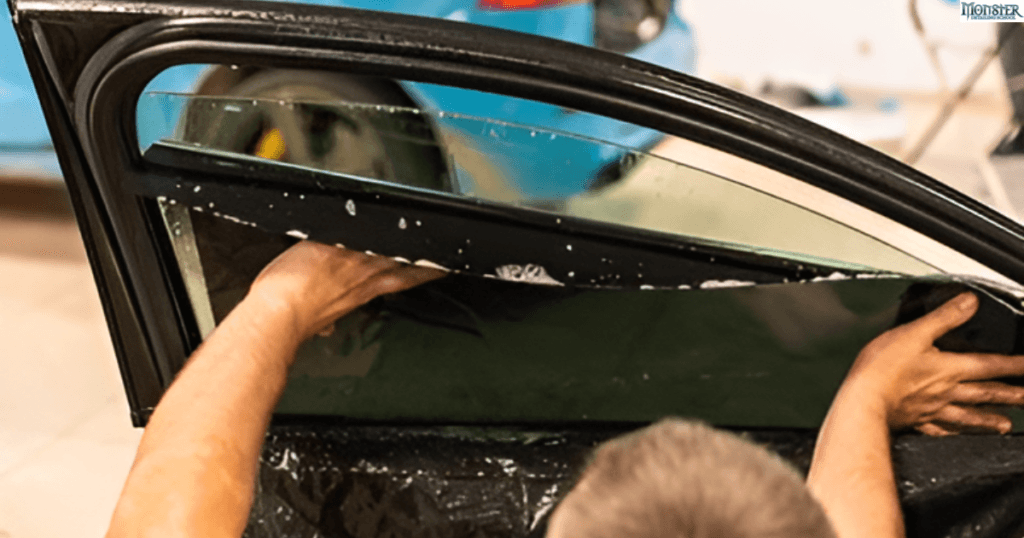Whatever You Need to Understand About Vehicle Window Tinting for Your Car
Car window tinting is a functional enhancement for lots of vehicle owners. It offers advantages such as raised comfort and power efficiency. Various tint films deal with various requirements and choices. Comprehending legal guidelines and picking the right color portion is vital. The installment process and proper upkeep likewise play substantial roles in making certain the durability of the tint. What other elements should one take into consideration before choosing on window tinting?
Benefits of Automobile Home Window Tinting
Some lorry proprietors may forget it, automobile window tinting offers many benefits that enhance both the driving experience and the vehicle's durability. One of the primary benefits is the reduction of warm build-up inside the car, permitting a much more comfy experience, especially throughout heat. This can bring about reduced dependence on air conditioning, improving gas efficiency.Additionally, window tinting gives protection against hazardous UV rays, which can cause skin damage and discolor interior materials gradually. By obstructing these rays, the color aids preserve the vehicle's interior and keep its resale value.Moreover, tinted windows can enhance personal privacy and safety, as they make it extra hard for outsiders to see inside the car. This added layer of defense can deter possible burglary. Generally, car home window tinting works as a practical investment that adds to both comfort and the lorry's total wellness.
Kinds Of Home Window Color Films
When considering automobile home window tinting, vehicle proprietors run into a range of window color movies, each created to fulfill specific needs and choices. The first group is dyed window movie, which offers a fundamental degree of personal privacy and UV protection while being cost-effective. Next off, metalized movies integrate tiny metallic particles, showing warmth and boosting sturdiness, although they may hinder digital signals.Ceramic films are one more option, understood for their remarkable warm denial and clearness, supplying high efficiency without signal disturbance. Crossbreed films integrate characteristics of dyed and metalized films, striking a balance in between cost and performance. Each kind of home window tint film presents unique advantages, enabling vehicle owners to choose based on their particular needs, such as warm spending plan, control, and look considerations. Recognizing these choices is crucial for making a notified choice relating to automobile home window tinting.
Recognizing Legal Rules
When thinking about automobile home window tinting, it is important to recognize the legal guidelines that govern color darkness restrictions and windscreen color demands. These guidelines can differ substantially from one state to another, affecting what is permissible for automobile owners. Familiarizing oneself with these laws warranties conformity and assists prevent possible penalties or penalties.
Color Darkness Limitations
Exactly how can automobile proprietors ensure they remain compliant with neighborhood regulations relating to home window tinting? Recognizing color darkness limits is important. Each state has details regulations that dictate the acceptable degrees of darkness for home window tints, which are determined by Visible Light Transmission (VLT) portions. Typically, front-side home windows need to allow a greater percentage of light contrasted to back windows. For example, some states might permit only 30% VLT for front home windows, while the back windows could be allowed to have especially darker tints. To assure compliance, automobile proprietors need to get in touch with state guidelines or neighborhood regulation enforcement for exact details. Additionally, licensed tinting specialists can provide understandings regarding lawful limitations, ensuring that lorry proprietors make notified choices.
Windscreen Color Laws

State-Specific Legislations
Guiding with the landscape of state-specific legislations pertaining to car home window tinting calls for mindful interest to information, as regulations can vary substantially from one state to an additional. Each state has its own set of guidelines governing permitted color portions, sorts of materials, and placement on lorry home windows. Some states permit darker colors on back home windows while banning them on front windows, while others have more stringent overall limitations (automotive window tinting clinton township). Additionally, certain states mandate the use of particular products or require certification from installers. Failing to adhere to these policies can result in penalties or the need to get rid of non-compliant color. Car owners ought to consult their state's Department of Motor Vehicles or relevant authority to assure adherence to regional regulations.
Selecting the Right Tint Percentage
When selecting the ideal color percentage for a vehicle's windows, one have to consider various variables that affect both looks and functionality. Color percents commonly vary from 5% to 70%, with reduced portions providing darker tones and greater portions enabling extra light in. A darker tint can enhance privacy and reduce glow, while a lighter tint can preserve visibility and abide by legal restrictions.Furthermore, individual choice plays a substantial role in this decision. Some people may like the sleek look of darker colors, while others may prefer a much more open, ventilated feel. In addition, the car's purpose should be thought about; for example, those utilizing their vehicles for industrial functions may go with lighter colors to preserve a professional look.Ultimately, the appropriate color percentage equilibriums personal design, comfort, and adherence to regional regulations, making certain an enjoyable tinting experience.
The Setup Refine
An effective setup of window tint calls for cautious attention to detail and the right devices. The process normally begins with extensive cleansing of the windows to eliminate dirt, dirt, and debris, guaranteeing proper bond of the film. When the surface areas are prepared, the installer procedures and cuts the color film to fit each window accurately.Next, the film is placed on the glass, usually utilizing an option to facilitate easy change and stop air bubbles. Warmth is sometimes related to the film to conform it to the home window's contours, boosting its appearance and longevity. After confirming a seamless fit, the installer diligently cuts any type of excess film along the edges.Finally, the installer checks for flaws and confirms all edges are safe and secure. This meticulous strategy is essential not only for aesthetics yet also for achieving the wanted performance benefits of window tinting, such as UV protection and warm decrease.
Upkeep and Look After Tinted Windows
Correct upkeep and treatment are vital for preserving the integrity of colored windows. Reliable cleaning strategies, the evasion of unsafe chemicals, and routine evaluations for damages play important functions in ensuring long life. By complying with these standards, automobile proprietors can maintain the practical and visual advantages of their home window tint.
Cleaning Up Strategies for Tint
Preserving the clarity and long life of colored home windows requires details cleansing methods tailored to the film's fragile surface area. It is important to use a soft microfiber towel to prevent scraping the color while cleaning. A gentle solution of water and a couple of decreases of light meal soap can properly remove dust and crud. It is recommended pop over here to apply the cleansing remedy to the fabric, instead of directly onto the colored surface, to avoid wetness from seeping into the edges of the movie. Mild, circular motions must be employed to clean up the home windows thoroughly. Normal cleansing aids maintain exposure and stops build-up, making sure that the color remains in prime condition over time. Adhering to these strategies will certainly expand the life of colored home windows.
Avoiding Hazardous Chemicals
Although many house cleaning products are efficient on numerous surface areas, they can position significant dangers to colored home windows. Chemicals such as ammonia, bleach, and particular solvents can weaken the color movie, bring about discoloration and peeling. People must go with pH-balanced cleaners specifically created for tinted home windows. In addition, utilizing soft microfiber fabrics will certainly aid avoid scrapes and maintain the color's stability. Regular maintenance is vital; as a explanation result, staying clear of rough scrubbing or unpleasant products is important. It is recommended to check out item labels very carefully to validate compatibility with window colors. By choosing the best cleansing solutions and devices, vehicle proprietors can protect the appearance and functionality of their tinted home windows, ensuring a longer life expectancy and height performance.
Inspecting for Damage
Routine assessments of colored windows are very important for recognizing any type of signs of damages that may jeopardize their efficiency and look. Owners need to seek gurgling, peeling, or discoloration, as these problems can indicate poor installment or exposure to harmful components. It is recommended to inspect the edges of the movie where peeling off may begin and check for any scrapes that could impact exposure. Additionally, ultraviolet (UV) rays can create the color to deteriorate with time, so checking its performance in obstructing UV light is important. If any type of damages is identified, punctual action needs to be taken, which might consist of professional repair work or substitute. Keeping tinted windows not just enhances visual appeals but also guarantees continued protection for both guests and the car inside.
Typical Myths Concerning Window Tinting
What misunderstandings border window tinting for lorries? Numerous people believe that all window tints are unlawful, but policies vary by state, enabling certain levels of tinting. One more typical myth is that darker colors block more warmth; nonetheless, the effectiveness of home window movies depends upon their technology rather than darkness. Some individuals additionally believe that window tinting is only for aesthetics, forgeting its advantages, such as UV defense and glow decrease. Additionally, numerous presume that home window tinting will harm their vehicle's glass, but professionally used colors can actually boost glass longevity. Ultimately, there is an idea that window colors block exposure, yet high-quality movies are made to keep clear sightlines while offering personal privacy. Understanding these myths helps consumers make educated choices regarding window tinting, ensuring they appreciate the full series of advantages it uses.
Often Asked Concerns
How Much Time Does Window Tinting Generally Last?
The durability of window tinting varies based upon factors such as setup top quality, film kind, and environmental problems. Typically, high-grade color can last anywhere from five to ten years prior to requiring substitute or reapplication.
Can I Remove Home Window Tint Myself?
Eliminating window color oneself is feasible, though it might be challenging. Individuals must use a warm resource and sticky cleaner to relieve the procedure, however caution is suggested to prevent harming the lorry's glass or interior.
What Tools Are Needed for Do It Yourself Window Tinting?

Will Window Tinting Damages My Auto's Glass?
Home window tinting, when used correctly, usually does not damage a car's glass. Inappropriate setup or low-grade films may lead to peeling, bubbling, or scraping, possibly compromising the stability of the glass over time.
Can Tinted Windows Impact My Car's Resale Worth?
The impact of colored windows on a car's resale worth can vary. While some customers value the added privacy and UV protection, others might watch it as a prospective issue, potentially influencing resale favorably or adversely. When considering auto window tinting, vehicle owners encounter a variety of window tint movies, each developed to fulfill certain demands and preferences. When considering automobile window tinting, it is vital to recognize the legal policies that govern color darkness restrictions and windscreen color requirements. Usually, front-side windows should allow a greater portion of light contrasted to back windows. Some states might enable only 30% my company VLT for front home windows, while the back windows could be allowed to have significantly darker tints. Some states allow darker tints on back home windows while banning them on front home windows, while others have stricter total limitations.